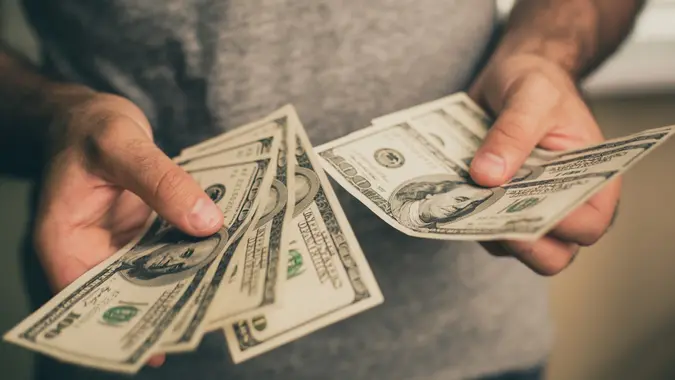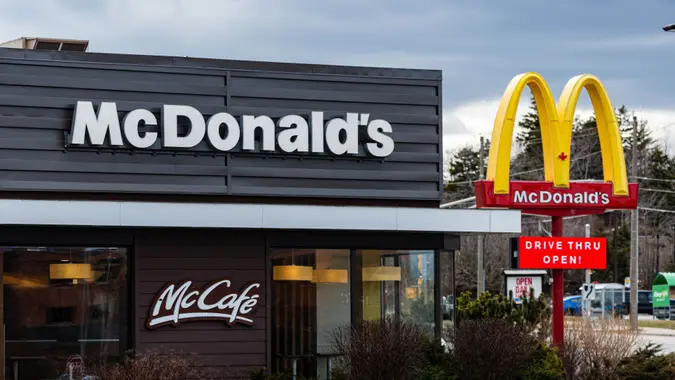Advertiser Disclosure
GOBankingRates works with many financial advertisers to showcase their products and services to our audiences. These brands compensate us to advertise their products in ads across our site. This compensation may impact how and where products appear on this site. We are not a comparison-tool and these offers do not represent all available deposit, investment, loan or credit products.
Before You Vote, See the Eye-Popping Numbers Behind the Coronavirus Recession
 Written by
Andrew Lisa
Written by
Andrew Lisa

Commitment to Our Readers
GOBankingRates' editorial team is committed to bringing you unbiased reviews and information. We use data-driven methodologies to evaluate financial products and services - our reviews and ratings are not influenced by advertisers. You can read more about our editorial guidelines and our products and services review methodology.

20 YearsHelping You Live Richer

Reviewed by Experts

Trusted by Millions of Readers
About nine months after word of a new, scary and highly contagious disease began buzzing across social media, the president of the United States was hospitalized with coronavirus and a quarter-million American deaths are on the horizon. Also, there’s an election right around the corner. With COVID-19 now glued to the ballot for both parties, it would be an understatement to say that a lot is at stake on Nov. 3. Here are the numbers on the economic fallout from the virus’ wrath.
Global Economy: 4.9% Annual Decline
In April, the International Monetary Fund (IMF) predicted a 3% drop in global economic growth for 2020, which already would have represented the worst worldwide economic downturn since the Great Depression. By June, however, the true magnitude of the crisis had emerged and the IMF revised its prediction to an even more dire 4.9%.
US GDP: 32.9% Quarterly Decline
America’s gross domestic product (GDP), a primary metric used to gauge economic expansion and recession, declined by 32.9% in the second and most recent Bureau of Economic Analysis (BEA) quarterly report. It was the worst decline ever reported since estimates began in 1947. For context as to just how dramatic that drop is, the No. 2 worst quarterly decrease ever recorded was 10% in March 1958. The worst decline during the Great Recession was 8.4%.
US GDP: 9.5% Annual Decline
According to Forbes, the BEA distorts its quarterly GDP reports by presuming the quarter’s results will continue throughout the year. That, the publication concludes, makes the year-over-year decline actually more like a much peachier 9.5%. Even that far more forgiving assessment, however, represents the largest annual decline in U.S. GDP ever recorded.
US Economic Output: $2.1 Trillion Decline
Before the GDP cratered by nearly one-third in the second quarter, it lost 5% in the first quarter of 2020. It’s often hard for the layperson to quantify what, exactly, percentages like that represent. According to Forbes, those percentages translate into a loss of $2.1 trillion in economic output in just two quarters.
Wages: 8% Decline
Part of the reason for the contracting economy is that anxious Americans became more frugal. America’s household savings rate jumped to a record 33% in April as personal income increased by 10.5% that month. But according to Reuters, it was mostly an illusion created by a “welfare economy.” That rosy picture, after all, was colored by $3 trillion in federal CARES Act relief spending. In reality, income dropped by 6.3% and wages dropped by 8%.
US Unemployment Rate: 10.6% Increase
In February, the unemployment rate was at a near-historic low of 3.8%. By April, it had climbed to 14.4%. That’s a jobless rate increase of 10.6% in just two months. Coincidentally, unemployment peaked at exactly 10.6% at the height of the Great Recession, nearly 4 percentage points lower than the peak of the COVID-19 crisis. Although the jobless rate has since fallen to around 8% today, the moment — similar to the GDP freefall — could serve as a harbinger of things to come should the virus’ expected second wave materialize.
Hiring Rate: 39.6% Annual Decline
According to LinkedIn’s September Workforce Report 2020, hiring was down 11.3% as of August compared to the same time last year. Even that steep, double-digit drop is a huge step up from the monthly LinkedIn report released in July, which reported a decline in hiring of 39.6% compared to the same time last year. That’s about where it had remained since April.
Furloughs: 2-Month Increase of 17.3 Million
In February, roughly 801,000 Americans were furloughed — not working or earning an income, but technically still employed — according to the Bureau of Labor Statistics (BLS). By April, that number had skyrocketed to nearly 18.1 million.
Dow Jones Industrial Average: 2,997.1-Point Single-Day Decline
In mid-March, the Dow Jones Industrial Average suffered its worst single-day point drop in history when the index cratered by 2,353. Four days later, the Dow found itself in the unenviable position of breaking that record with a 2,997.1-point drop. In total, the Dow dropped by roughly 8,527 points in a little more than a month between Feb. 12 and March 18. It has since rebounded, but experts worry a repeat or worse could be on the horizon when the predicted second wave of COVID-19 strikes.
Price of Oil: 50% Monthly Decline
At the end of March, oil prices had cratered by more than half over the course of that month, according to the Financial Times. With the virus bringing jets, cars and factories to a screeching halt, demand dropped more than it ever had in history. At its worst, prices dropped below the key psychological barrier of $20 a barrel. Oil lost 24% of its value on a single Wednesday as prices reached lows not seen since the run-up to the Iraq War in 2002.
Worldwide Airline Revenues: $314 Billion Decline
Much of the reason for oil’s freefall can be traced to a year-over-year decline in flights that breached 90% in some countries. According to data from Statista, flights worldwide declined by more than 65% in June compared to the same month in 2019, and the industry as a whole is expected to lose $314 billion in revenues on the year.
Consumer Confidence Index: 46-Point Decline
The Consumer Confidence Index is a key economic indicator, and it recently offered some welcome news when it jumped above 100 in September for the first time since the start of the coronavirus crisis. Before the pandemic, it was floating at a now-enviable 132.6, but by August it was down 46 points to 86.6. Anything below 100 represents a collectively jittery consumer sentiment.
Permanent Business Closures: Increase of 97,966
In September, Yelp released its 2020 Local Economic Impact Report. As of the end of August, 163,735 businesses had closed since the beginning of the pandemic on March 1. The report concluded that 97,966 of those businesses were not reopening. That means about 60% of all the businesses shuttered by COVID-19 will go down as permanent closures.
Food Bank Recipients: 20% Increase
In July, Feeding America reported that between March and June, the country’s food banks served 1.9 billion people struggling with food shortages. That’s an increase of 20% over the same time last year, which means that 6 billion meals will be needed to serve that same population in a year as the crisis is now threatening 1 in 6 Americans with hunger.
US COVID-19 Cases: Increase of 7.4 Million
According to the Centers for Disease Control and Prevention, America’s first coronavirus case was confirmed on Jan. 20. By the end of February, 60 cases had been confirmed. More than 184,000 cases had been confirmed just one month later at the end of March, and by the time this article was written in early October, the U.S. was grappling with roughly 7.4 million confirmed cases of COVID-19.
US Coronavirus Deaths: Increase of 210,000
It’s now known that America’s first COVID-19 fatality occurred on Feb. 6 in Santa Clara County in California’s Bay Area — not at the end of the month as previously believed. By the time this article was written in early October, that number had soared to roughly 210,000 with no vaccine, no national containment strategy, no end in sight and no one truly safe, even the president of the United States.
Wealth of America’s Billionaires: $637 Billion Increase
It seems that for America’s three-comma club, the economy is always good. According to Business Insider, the TARP program gave 90% of federal relief dollars to banks and corporations and just 10% to homeowners during the Great Recession a dozen years ago. That same pattern emerged again during the COVID-19 crisis, only this time, big, publicly-traded corporations were allowed to gobble up hundreds of millions of dollars in funds meant to keep small businesses afloat. Also like the Great Recession, when the stock market bounced back, the rich were flush with cash to take advantage of the rebound while 40 million Americans were out of work and 40% didn’t have enough cash to cover a $400 emergency.
Projected Votes Cast: 10 Million-Plus Increase
According to Brookings, it’s possible and even likely that the 2020 election will witness “once-in-a-century, massive turnout” among voters. Recent Pew research reveals a huge uptick in voter engagement and a deep-seated belief among large and nearly equal percentages of voters in both parties that the stakes are higher than they’ve ever been. With a sharply divided electorate united only in the belief that the future of the country is on the line, it’s quite possible that 145 million votes will be cast this fall as opposed to 133 million in 2016, according to Brookings.
More From GOBankingRates
Share this article:




You May Also Like


If Michael Jordan's Wealth Were Evenly Distributed Across America, How Much Money Would Every Person Get?
December 24, 2025
8 min Read




4 Financial Tasks I Stopped Paying Experts for After Discovering ChatGPT
December 26, 2025
8 min Read


2026's 10 Highest Paying, Fast-Growing Jobs That Don't Require a College Degree
December 24, 2025
8 min Read


I Used To Work at McDonald's -- Here's How It Made Me Better With Money
December 26, 2025
8 min Read


If the Top 1% Paid Double in Taxes, How Much Could Every Citizen Receive in Universal Basic Income?
December 23, 2025
8 min Read

I Asked ChatGPT Which US Cities Will Be Most Affordable by 2027 -- Here's What It Said
December 18, 2025
8 min Read
Questions Around The Economy
Make your money work for you
Get the latest news on investing, money, and more with our free newsletter.
By subscribing, you agree to our Terms of Use and Privacy Policy. Unsubscribe at any time.


Thanks!
You're now subscribed to our newsletter.
Check your inbox for more details.



Sending you timely financial stories that you can bank on.
Sign up for our daily newsletter for the latest financial news and trending topics.
For our full Privacy Policy, click here.
Looks like you're using an adblocker
Please disable your adblocker to enjoy the optimal web experience and access the quality content you appreciate from GOBankingRates.
- AdBlock / uBlock / Brave
- Click the ad blocker extension icon to the right of the address bar
- Disable on this site
- Refresh the page
- Firefox / Edge / DuckDuckGo
- Click on the icon to the left of the address bar
- Disable Tracking Protection
- Refresh the page
- Ghostery
- Click the blue ghost icon to the right of the address bar
- Disable Ad-Blocking, Anti-Tracking, and Never-Consent
- Refresh the page




